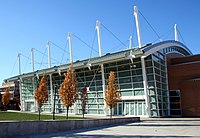
Photo from wikipedia
In this essay, it is my intent to examine the history of architectural history's intersection with the profession of architecture in the United States.1 A common lens for viewing this… Click to show full abstract
In this essay, it is my intent to examine the history of architectural history's intersection with the profession of architecture in the United States.1 A common lens for viewing this evolving relationship is that of academia—that is, how architectural history has figured within architectural education. Instead, I will take a more arcane object of investigation: the architectural licensing exam. Since its inception in the 1920s, architectural history has been a constituent element of the tests that individuals must pass in order to call themselves architects. Thus, the licensing exam is the profession's deliberated and institutionalized statement of the status of architectural history, and an examination of the exam reveals the history of architectural history in relation to the profession of architecture. It is my argument that the mutable nature of this relationship demonstrates architectural history's sensitive tracking of the profession's status in the American political economy and, in turn, architectural history's fluctuation between autonomy and instrumentality within the profession. I will suggest in conclusion that architectural history is now capable of a “speculative turn,” building on Hayden White's idea of a “practical past.” At the end of the nineteenth century, architecture professionalized in the United States. At that time, architectural history was an intriguingly material study based on Beaux-Arts training that moved into the offices of architects like H. H. Richardson, whose apprentices studied ornament not just through precedents presented in books but also through plaster casts of sculpture and architectural fragments from antiquity. If books of precedent and architectural drawings constituted a significant part of the libraries in offices like H. H. Richardson's or McKim, Mead and White, the most likely textbook in schools was Banister Fletcher's A History of Architecture .2 It remained a if not the core text through the 1930s, when Joseph Esherick recalled …
Journal Title: Journal of the Society of Architectural Historians
Year Published: 2017
Link to full text (if available)
Share on Social Media: Sign Up to like & get
recommendations!